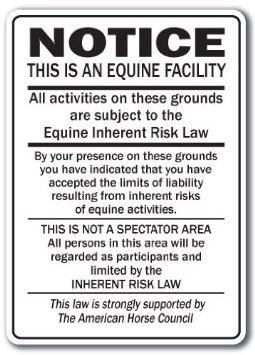 As every horse owner probably knows, while horse ownership has many rewards, it also comes with its fair share of woes, including the potential for liability.
As every horse owner probably knows, while horse ownership has many rewards, it also comes with its fair share of woes, including the potential for liability.
In last month’s article I talked about the concepts of negligence and strict liability, and when they may apply to situations involving your horse’s behavior. After reading that article, someone raised a question as to why a horse owner, in the situations described, wouldn’t be shielded from liability under the Equine Liability Statutes.
It was a good question, and I want to clarify the point that, while the Equine Liability Statutes adopted by most states serve to limit liability for many horse-related activities, the protection provided by those statutes is not all-inclusive. It is a mistake to think they will protect you in any situation. There are circumstances that fall outside of the protection afforded by the Equine Liability Statutes. There are also times when the people or activities involved are simply not covered by the statute. One such situation involves an ancient edict known as the “attractive nuisance doctrine.” It is certainly not common, but it exists, and can cause a host of problems for the unwary horse owner.
Generally speaking, a property owner owes no duty to trespassers, that is, people who enter onto his or her property without permission. Consequently, if a trespasser gets hurt while on someone’s property without permission, in most instances, a homeowner is not responsible for those injuries. I say “most instances” because there are exceptions to every rule, and the “attractive nuisance” doctrine is one such exception. The attractive nuisance doctrine protects minors and other incompetent persons who come onto private property, uninvited, because something has drawn their attention.
The theory is, if a child or other person with diminished mental capacity sees something enticing on someone else’s property, they will go to it, regardless of the dangers involved. The exaggerated law school example I recall is the story of a man who built a Ferris wheel on his property and surrounded it with bear traps. Wouldn’t he expect children to be drawn to the Ferris wheel? And shouldn’t he be held responsible when the children step into the bear traps trying to get to the ride?
 Courts have applied the attractive nuisance doctrine to allow child trespassers to recover for injuries suffered if they are enticed onto a person’s property because of an attractive nuisance, regardless of whether or not the landowner meant to entice them. This is because children, especially very young children, don’t often respect property boundaries and don’t necessarily appreciate the danger involved in certain situations. Where an adult sees a piece of broken glass, a 7-year-old child might see a shiny bauble to play with.
Courts have applied the attractive nuisance doctrine to allow child trespassers to recover for injuries suffered if they are enticed onto a person’s property because of an attractive nuisance, regardless of whether or not the landowner meant to entice them. This is because children, especially very young children, don’t often respect property boundaries and don’t necessarily appreciate the danger involved in certain situations. Where an adult sees a piece of broken glass, a 7-year-old child might see a shiny bauble to play with.
So what, exactly, is an attractive nuisance? The definition has been open to interpretation in the Courts, but basically it refers to any potentially harmful object or condition on a person’s property that, by its nature, tends to attract children. It typically doesn’t apply to naturally occurring conditions, such as ponds or rock outcroppings, but applies to conditions that are created by the landowner. Anyone who has a swimming pool on their property may already be familiar with this doctrine since a swimming pool is often considered an “attractive nuisance,” in that children tend to be drawn to it but don’t always appreciate the dangers involved. In fact, it is because of this doctrine that most insurance companies require homeowners who have a swimming pool to take extra precautions to protect against child trespassers.
But what about horses? Children tend to be attracted to horses, and we all know that even the most docile of horses can be dangerous, especially when startled. So should a beautiful horse out in an open pasture be considered an attractive nuisance? Consider this situation: Your neighbor down the road is hosting a party for his family. While no one is looking, his 8-year-old nephew wanders away, walks down the road, and spots your horse grazing on your property. He crawls under your post-rail fence to have a closer look. The horse, normally quite tame, is startled when the boy approaches from behind. The horse bolts and the boy is injured. Should you be held responsible? Well, recently, some Courts have found that horses are indeed considered an attractive nuisance and, in the situation described, you might very well be held liable for the young boy’s injuries. Granted, this theory of a horse as an attractive nuisance has not often been tested in Courts, but it appears that where it has, the cases have met with some success.
Of course, liability is not automatic, and the injured party must still prove his case. When determining attractive nuisance cases, Courts consider several factors, including:
- Whether the property owner knew that a child could trespass on the property (i.e. the property is not adequately fenced in; children use the property as a shortcut; children frequent the area; etc.);
- The attractive hazard poses an extreme risk of injury or death (this doesn’t need to be as obvious as a bear trap, but should be apparent to a reasonably-minded adult);
- Could a child be expected to appreciate full extent of the risk;
- Whether it would have been practical (or even possible) for the property owner to have eliminated the risk in light of the potential danger involved;
- Whether the property owner took any measures to protect child trespassers against the risk.
For horse owners, it is wise to keep these criteria in mind, and to take precautions to lessen any potential liability should a child trespasser wander onto your property to have a look at your horse (or for any other reason). These precautions could include such measures as:
- Pasturing your horse in an area that is not readily accessible or easily visible to children.
- Making sure your property is surrounded by a fence that children cannot easily get over or under.
- As far as possible, keep your horse in sight when he’s out of the barn.
Odds are, you may never be faced with the situation where a child trespasses upon your property and suffers injury. But it does happen, and if it happens to you, these simple precautions can help you defeat any claim brought against you under the attractive nuisance doctrine.
Mati Jarve is the managing partner of the Marlton, New Jersey law firm of Jarve Kaplan Granato, LLC. He is certified by the New Jersey Supreme Court as a Civil Trial Attorney and theNational Board of Trial Attorneys as a Trial Advocate. Licensed in New Jersey, Pennsylvania and Arizona, he maintains a national practice in civil litigation, including equine related issues. This article is for informational purposes only and is not intended to be legal advice. If you have a specific legal question or problem you should consult with an experienced and knowledgeable equine law attorney. Questions, comments or suggestions can be e-mailed to mjarve@nj-triallawyers.com, by visiting www.nj-triallawyers.com.



You must be logged in to post a comment Login